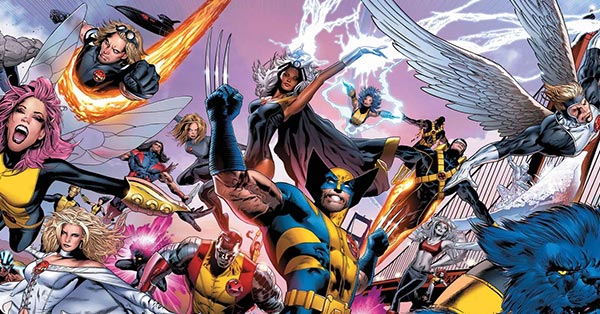If you were worried that my weekly series of X-Men Guide updates would go on hiatus during my Indie Comic Month, have no fear! There’s no higher priority for me at Crushing Comics than getting every one of my X-Guides completely up-to-date! However, it turns out there wasn’t too much to update in this guide, which is for the first era of Uncanny X-Men to be completely collected in color. It’s my guide to Guide to Uncanny X-Men in the 00s – The Trade Paperback Era!
Guide to Uncanny X-Men in the 00s – The Trade Paperback Era
I titled this guide “The Trade Paperback Era” because it picks up Uncanny X-Men in the 00s as Marvel began to transition to the standard practice of issuing trade paperback collections of almost every series as their story arcs completed.
The trade paperback era represents a massive shift in the comic industry. Not only did it change the way comic stories were structured as authors began “writing for trade,” but it created an entirely new market of readers! Readers who might previously drop into a comic store only a few times a year no longer had to suffer for their lack of a pull list. And, whenever a series started to accumulate a critical mass of popularity or acclaim, it could be easily ordered by book stores.
Previously, regular trade paperback releases were mainly reserved for prestigious, adult-oriented series like Sandman, whose readers might never venture out of a bookstore and into a comic shop. A key story arc or crossover from a superhero comic might see trade release, but Marvel and DC weren’t in the practice of collecting every issue of every title.
Suddenly, everything was recollected.
(Actually, it wasn’t so sudden – Marvel started in 2000 but you can still find some gaps in their trade coverage as late as 2006.)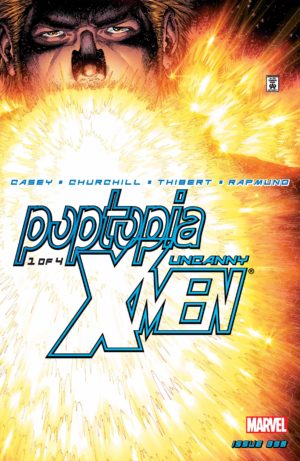
You can watch this shift happen in real time in Uncanny X-Men in the 00s. Issues #394-399 were collected in a one-off, unnumbered trade. Then, there was no collection of issues #400-409, but numbered trade collections began with issue #410 and never ended after that.
That means that this era of Uncanny X-Men was the most easily-accessible for adults returning to the world of comics any time in the past 20 years. That’s a demographic group that includes me! Instead of tracking down more than 150 back issues to follow this story, I was able to do it in just 30 trades – all but seven of which were readily in-stock at the time.
Whether you realize it or not, Marvel hews closely to Disney’s “vault” system when it comes to much of their reprint strategy. They’ll reprint wildly popular runs many times over, but they also eventually get around to recollecting previously collected things every 7-10 years.
It’s no coincidence their Complete Collection coverage of this era began in 2013 and wrapped up in 2020, and I think we can expect new collections to begin again sometime next year. The big question is whether they will be Omnibuses (of which this run has ZERO), the new “Modern Epic” line, or simply a continuation of the existing X-Men Epic line.
Let’s take a look at that “Complete Collection” coverage of the last decade, and how it seriously fails one out of the six authors who together penned this decade of Uncanny X-Men. All of this is covered in much-greater detail in the full Guide to Uncanny X-Men in the 00s – The Trade Paperback Era – including issue ranges, full collection contents, the original trade collections, information about parallel titles and Marvel events, and links to read on Marvel Unlimited.
Uncanny X-Men by Joe Casey
First, in Uncanny X-Men (1963) #394-409 Joe Casey picked up the Uncanny baton from Chris Claremont’s Revolution in 2001 at the same time Grant Morrison was launching their New X-Men. Casey’s run was adult and weird in a similar vein to Morrison’s, but never caught fire in the same way.
Casey’s run has been recollected in a single trade: X-Men: X-Corps (2013 paperback, ISBN 978-0785185024 / digital), which we could just as easily call “X-Men by Joe Casey Complete Collection.
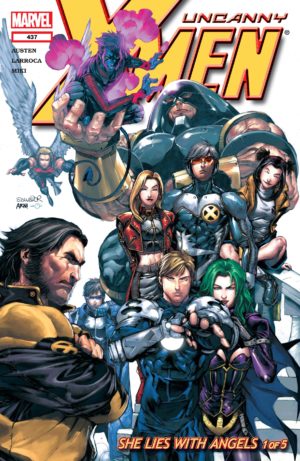
Uncanny X-Men by Chuck Austen
Then, Chuck Austen took over Uncanny X-Men (1963) #410-443 (and continued his run back into X-Men (1991) after Morrison’s departure). This is almost-certainly the most-hated flagship X-Men run of all time by fans!
Personally, I’ve never got the hate. It has just as many soap opera elements as Claremont’s X-Men with just as many cringe-inducing turns of plot. I think what sets it apart is that it really leans into the campy aspects of its soap opera plots, which tends to turn off people who take comics very seriously. Also, two of the cringe-y plot developments are among the worst of all time – Nightcrawler being part-demon and Angel and Paige having sex in mid-air.
Austen’s run has been completely recollected in three volumes, though they avoid being called “Chuck Austen” collections on the spine for obvious reasons: X-Men: Unstoppable (2018 paperback, ISBN 978-1302916121 / digital), X-Men: Trial of the Juggernaut (2019 paperback, ISBN 978-1302920371 / digital), and X-Men: Reload (2020 paperback, ISBN 978-1302924010 / digital), which also includes his X-Men (1991) run.
Uncanny X-Men by Chris Claremont (again!)
Next, Chris Claremont returns for his third turn at writing X-Men. Or, maybe it’s his fourth, if you include X-Treme. Or, I suppose we could call it more of his second run, which was continuous from Revolution to X-Treme to this portion of Uncanny. This return is sometimes branded as “Reload” and sometimes as “The New Age.”
I am a massive fan of this run. I think Claremont is in fine form – much tighter than he was on X-Treme. And, it has a cast I love – including a heavy focus on Rachel Summers.
Claremont’s return is completely recollected in two volumes – X-Men: Reload By Chris Claremont Vol. 1 – The End of History (2018 paperback, ISBN 978-1302913786 / digital) and X-Men: Reload by Chris Claremont Vol. 2 – House of M (2019 paperback, ISBN 978-1302920531 / digital).
Uncanny X-Men by Ed Brubaker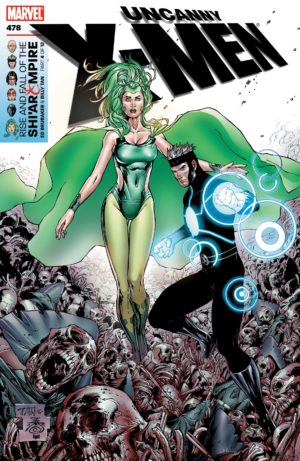
Now, things get complicated. Ed Brubaker takes over writing duties in Uncanny X-Men (1963) #475-499, but the prologue to his run happened in its own limited series – X-Men Deadly Genesis (2006), which was a sort of part-sequel, part-duet with the original Giant-Size X-Men (1975) #1.
Brubaker continued that plot directly into issues #475-486 for the X-Men’s best-ever space epic (yeah, you heard what I said), The Rise & Fall of the Shi’ar Empire. Then, Brubaker briefly returned his focus to Earth for issues #487-491 before the title was caught up in “Messiah Complex” for #492-494, and then he co-plotted with Matt Fraction from #495-499.
Recollecting this material poses a conundrum. Deadly Genesis and Rise & Fall have both been repeatedly collected along with Marvel’s mid-00s cosmic saga, as they’re both part of the run-up to War of Kings. While they could be mashed into a single Complete Collection, most of the demand for that material is linked to the event more than it is to X-Men. Then, the back half of his run is just 10 issues once you skip Messiah Complex – too short for a Complete Collection, so the material has lingered out of print since 2008!
(I think this requires a different solution in paperback than it does in omnibus, but I’ll save that for a future mapping post.)
Uncanny X-Men by Matt Fraction
After Brubaker comes Matt Fraction, penning Uncanny X-Men (1963) #500-534. This was the era where I returned to reading X-Men in 2010 with Second Coming. Much like the current Age of Krakoa, it’s a run that focuses less on the X-Men as a team and more on the X-Men as a nation.
That involved pulling in all extant mutants, including Namor and Magneto, plus former villains like Avalanche and Greycrow. Despite that massive cast, this is really the era of Scott & Emma. With Astonishing X-Men past its Whedon period, the pair of them become the heads of X and figured heavily into the plot of every issue.
Matt Fraction’s run has been recollected in three volumes, though I wouldn’t call it “completely,” since it leaves out some key non-Fraction material. Those are Uncanny X-Men: The Complete Matt Fraction Collection, Vol. 1 (2013 paperback, ISBN 978-0785165934/ digital), Uncanny X-Men: The Complete Matt Fraction Collection, Vol. 2 (2013 paperback, ISBN 978-0785165941 / digital), and Uncanny X-Men: The Complete Matt Fraction Collection, Vol. 3 (2013 paperback, 978-0785184508 / digital).
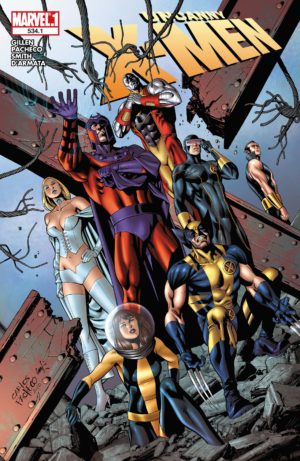
Uncanny X-Men by Kieron Gillen
Finally, we come to Kieron Gillen‘s run on Uncanny X-Men (1963) #534.1 & 535-545, which actually starts before Marvel says it starts and ends after Uncanny X-Men ends!
That’s because Gillen co-created all of the new “Generation Hope” mutants that appeared in Fraction’s arc from #526-529, and then co-wrote the following arc in #530-534. Then, Gillen continues his run after issue #545 for all 20 issues of Uncanny X-Men (2011), plus another five issues after that of AvX: Consequences!
This is my favorite run of X-Men after mid-80s Claremont. Gillen takes on a massive cast and understands how to get the most out of all of them. Plus, he invents the modern, moustache-twirling version of Mr. Sinister who would later be adopted by Jonathan Hickman.
Gillen’s run is collected in two volumes, though only the first includes issues from this run: Uncanny X-Men by Kieron Gillen: The Complete Collection, Vol. 1 (2019 paperback, ISBN 978-1302916497 / digital) and Uncanny X-Men by Kieron Gillen: The Complete Collection Vol. 2 (2020 paperback, ISBN / digital).
